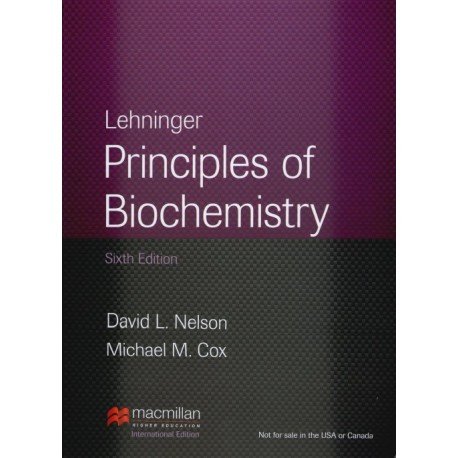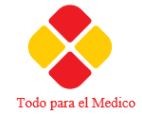Sin productos
Precios están sin IVA
Producto añadido correctamente a su carrito de compras
Hay 0 artículos en su carrito. Hay 1 artículo en su carrito.
¡Producto agregado con éxito a la cotización!
 Ver más grande
Ver más grande
En Existencia
Lehninger. Principles of Biochemistry
9781464109621
Autor : Nelson
Materia : Bioquímica
Editorial : Macmillan Higher Education
Año : 2013
Edición : 6th
Idioma : Inglés
ISBN : 9781464109621
Tamaño : 28cm x 22cm
Paginas : 1200
Encuadernación : Pasta dura
Tipo de Impresión : A color
Más información
LEHNINGER. PRINCIPLES OF BIOCHEMISTRY
The new sixth edition of this best-selling introduction to biochemistry maintains the clarity and coherence that so appeals to students whilst incorporating the very latest advances in the field, new worked examples and end of chapter problems and an improved artwork programme to highlight key processes and important lessons.
CONTENTS
1. The Foundations of Biochemistry
1.1 Cellular Foundations
1.2 Chemical Foundations
Box 1–1 Molecular Weight, Molecular Mass, and Their Correct Units
Box 1–2 Louis Pasteur and Optical Activity: In Vino, Veritas
1.3 Physical Foundations
Box 1–3 Entropy: Things Fall Apart
1.4 Genetic Foundations
2. Water
2.1 Weak Interactions in Aqueous Systems
2.2 Ionization of Water, Weak Acids, and Weak Bases
2.3 Buffering agains pH Changes in Biological Systems
Box 2-1 Medicine: On Being One's Own Rabbit (Don't Try This at Home!)
2.4 Water as a Reactant
2.5 The Fitness of Aqueous Environment for Living Organisms
3. Amino Acids, Peptides, and Proteins
3.1 Amino Acids
Box 3-1 Methods: Absorption of Light by Molecules: The Lambert-Beer Law
3.2 Peptides and Proteins
3.3 Working with Proteins
3.4 The Structure of Proteins: Primary Structure
Box 3–2 Consensus Sequences and Sequence Logos
4. The Three-Dimensional Structure of Proteins
4.1 Overview of Protein Structure
4.2 Protein Secondary Structure
Box 4–1 Methods: Knowing the Right Hand from the Left
4.3 Protein Tertiary and Quaternary Structures
Box 4–2 Permanent Waving Is Biochemical Engineering
Box 4–3 Why Sailors, Explorers, and College Students Should Eat Their Fresh Fruits and Vegetables
Box 4–4 The Protein Data Bank
Box 4–5 Methods: Methods for Determining the Three-Dimensional Structure of a Protein
4.4 Protein Denaturation and Folding
Box 4–6 Medicine: Death by Misfolding: The Prion Diseases
5. Protein Function
5.1 Reversible Binding of a Protein to a Ligand: Oxygen-Binding Proteins
Box 5–1 Medicine: Carbon Monoxide: A Stealthy Killer
5.2 Complementary Interactions between Proteins and Ligands: The Immune System and Immunoglobulins
5.3 Protein Interactions Modulated by Chemical Energy: Actin, Myosin, and Molecular Motors
6. Enzymes
6.1 An Introduction to Enzymes
6.2 How Enzymes Work
6.3 Enzyme Kinetics as an Approach to Understanding Mechanism
Box 6–1 Transformations of the Michaelis-Menten Equation: The Double-Reciprocal Plot
Box 6–2 Kinetic Tests for Determining Inhibition Mechanisms
Box 6–3 Curing African Sleeping Sickness with a Biochemical Trojan Horse
6.4 Examples of Enzymatic Reactions
6.5 Regulatory Enzymes
7. Carbohydrates and Glycobiology
7.1 Monosaccharides and Disaccharides
Box 7–1 Medicine: Blood Glucose Measurements in the Diagnosis and Treatment of Diabetes
Box 7–2 Sugar Is Sweet, and So Are . . . a Few Other Things
7.2 Polysaccharides
7.3 Glycoconjugates: Proteoglycans, Glycoproteins, and Glycolipids
7.4 Carbohydrates as Informational Molecules: The Sugar Code
7.5 Working with Carbohydrates
8. Nucleotides and Nucleic Acids
8.1 Some Basics
8.2 Nucleic Acid Structure
8.3 Nucleic Acid Chemistry
8.4 Other Functions of Nucleotides
9. DNA-Based Information Technologies
9.1 Studying Genes and Their Products
Box 9–1 A Powerful Tool in Forensic Medicine
9.2 Using DNA-Based Methods to Understand Protein Function
9.3 Genomics and the Human Story
Box 9–2 Medicine: Personalized Genomic Medicine
Box 9–3 Getting to Know the Neanderthals
10. Lipids
10.1 Storage Lipids
10.2 Structural Lipids in Membranes
Box 10–1 Medicine: Abnormal Accumulations of Membrane Lipids: Some Inherited Human Diseases
10.3 Lipids as Signals, Cofactors, and Pigments
10.4 Working with Lipids
11. Biological Membranes and Transport
11.1 The Composition and Architecture of Membranes
11.2 Membrane Dynamics
11.3 Solute Transport across Membranes
Box 11–1 Medicine: Defective Glucose and Water Transport in Two Forms of Diabetes
Box 11–2 Medicine: A Defective Ion Channel in Cystic Fibrosis
12. Biosignaling
12.1 General Features of Signal Transduction
Box 12–1 Methods Scatchard Analysis Quantifies the Receptor-Ligand Interaction
12.2 Protein–Coupled Receptors and Second Messengers
Box 12–2 Medicine: G Proteins: Binary Switches in Health and Disease
Box 12–3 Methods: FRET: Biochemistry Visualized in a Living Cell
12.3 Receptor Tyrosine Kinases
12.4 Receptor Guanylyl Cyclases, cGMP, and Protein Kinase G
12.5 Multivalent Adaptor Proteins and Membrane Rafts
12.6 Gated Ion Channels
12.7 Integrins: Bidirectional Cell Adhesion Receptors
12.8 Regulation of Transcription by Nuclear Hormone Receptors
12.9 Signaling in Microorganisms and Plants
12.10 Sensory Transduction in Vision, Olfaction, and Gustation
Box 12–4 Medicine: Color Blindness: John Dalton’s Experiment from the Grave
12.11 Regulation of the Cell Cycle by Protein Kinases
12.12 Oncogenes, Tumor Suppressor Genes, and Programmed Cell Death
Box 12–5 Medicine: Development of Protein Kinase Inhibitors for Cancer Treatment
13. Bioenergetics and Biochemical Reaction Types
13.1 Bioenergetics and Thermodynamics
13.2 Chemical Logic and Common Biochemical Reactions
13.3 Phosphoryl Group Transfers and ATP
Box 13–1 Firefly Flashes: Glowing Reports of ATP
13.4 Biological Oxidation-Reduction Reactions
14. Glycolysis, Gluconeogenesis, and the Pentose Phosphate Pathway
14.1 Glycolysis
Box 14–1 Medicine: High Rate of Glycolysis in Tumors Suggests Targets for Chemotherapy and Facilitates Diagnosis
14.2 Feeder Pathways for Glycolysis
14.3 Fates of Pyruvate under Anaerobic Conditions: Fermentation
Box 14–2 Athletes, Alligators, and Coelacanths: Glycolysis at Limiting Concentrations of Oxygen
Box 14–3 Ethanol Fermentations: Brewing Beer and Producing Biofuels
14.4 Gluconeogenesis
14.5 Pentose Phosphate Pathway of Glucose Oxidation
Box 14–4 Medicine: Why Pythagoras Wouldn’t Eat Falafel: Glucose 6-Phosphate Dehydrogenase Deficiency
15. Principles of Metabolic Regulation
15.1 Regulation of Metabolic Pathways
15.2 Analysis of Metabolic Control
Box 15–1 Methods: Metabolic Control Analysis: Quantitative Aspects
15.3 Coordinated Regulation of Glycolysis and Gluconeogenesis
Box 15–2 Isozymes: Different Proteins That Catalyze the Same Reaction
Box 15–3 Medicine: Genetic Mutations That Lead to Rare Forms of Diabetes
15.4 The Metabolism of Glycogen in Animals
Box 15–4 Carl and Gerty Cori: Pioneers in Glycogen Metabolism and Disease
15.5 Coordinated Regulation of Glycogen Synthesis and Breakdown
16. The Citric Acid Cycle
16.1 Production of Acetyl-CoA (Activated Acetate)
16.2 Reactions of the Citric Acid Cycle
Box 16–1 Moonlighting Enzymes: Proteins with More Than One Job
Box 16–2 Synthases and Synthetases; Ligases and Lyases; Kinases, Phosphatases, and Phosphorylases: Yes, the Names Are Confusing!
Box 16–3 Citrate: A Symmetric Molecule That Reacts Asymmetrically
16.3 Regulation of the Citric Acid Cycle
16.4 The Glyoxylate Cycle
17. Fatty Acid Catabolism
17.1 Digestion, Mobilization, and Transport of Fats
17.2 Oxidation of Fatty Acids
Box 17–1 Fat Bears Carry Out ? Oxidation in Their Sleep
Box 17–2 Coenzyme B12: A Radical Solution to a Perplexing Problem
17.3 Ketone Bodies
18. Amino Acid Oxidation and the Production of Urea
18.1 Metabolic Fates of Amino Groups
18.2 Nitrogen Excretion and the Urea Cycle
Box 18–1 Medicine: Assays for Tissue Damage
18.3 Pathways of Amino Acid Degradation
Box 18–2 Medicine:Scientific Sleuths Solve a Murder Mystery
19. Oxidative Phosphorylation and Photophosphorylation Oxidative Phosphorylation
19.1 Electron-Transfer Reactions in Mitochondria
Box 19–1 Hot, Stinking Plants and Alternative Respiratory Pathways
19.2 ATP Synthesis
Box 19–2 Methods: Atomic Force Microscopy to Visualize Membrane Proteins
19.3 Regulation of Oxidative Phosphorylation
19.4 Mitochondria in Thermogenesis, Steroid Synthesis, and Apoptosis
19.5 Mitochondrial Genes: Their Origin and the Effects of Mutations
Photosynthesis: Harvesting Light Energy
19.6 General Features of Photophosphorylation
19.7 Light Absorption
19.8 The Central Photochemical Event: Light-Driven Electron Flow
19.9 ATP Synthesis by Photophosphorylation
19.10 The Evolution of Oxygenic Photosynthesis
20. Carbohydrate Biosynthesis in Plants and Bacteria
20.1 Photosynthetic Carbohydrate Synthesis
20.2 Photorespiration and the C4 and CAM Pathways
Box 20–1 Will Genetic Engineering of Photosynthetic Organisms Increase Their Efficiency?
20.3 Biosynthesis of Starch and Sucrose
20.4 Synthesis of Cell Wall Polysaccharides: Plant Cellulose and Bacterial Peptidoglycan
20.5 Integration of Carbohydrate Metabolism in the Plant Cell
21. Lipid Biosynthesis
21.1 Biosynthesis of Fatty Acids and Eicosanoids
Box 21–1 Medicine: Mixed-Function Oxidases, Cytochrome P-450s and Drug Overdoses
21.2 Biosynthesis of Triacylglycerols
21.3 Biosynthesis of Membrane Phospholipids
21.4 Cholesterol, Steroids, and Isoprenoids: Biosynthesis, Regulation, and Transport
Box 21–2 Medicine: ApoE Alleles Predict Incidence of Alzheimer’s Disease
Box 21–3 Medicine: The Lipid Hypothesis and the Development of Statins
22. Biosynthesis of Amino Acids, Nucleotides, and Related Molecules
22.1 Overview of Nitrogen Metabolism
Box 22–1 Unusual Lifestyles of the Obscure but Abundant
22.2 Biosynthesis of Amino Acids
22.3 Molecules Derived from Amino Acids
Box 22–2 On Kings and Vampires
22.4 Biosynthesis and Degradation of Nucleotides
23. Hormonal Regulation and Integration of Mammalian Metabolism
23.1 Hormones: Diverse Structures for Diverse Functions
Box 23–1 Medicine: How Is a Hormone Discovered? The Arduous Path to Purified Insulin
23.2 Tissue-Specific Metabolism: The Division of Labor
Box 23–2 Creatine and Creatine Kinase: Invaluable Diagnostic Aids and the Muscle Builder’s Friends
23.3 Hormonal Regulation of Fuel Metabolism
23.4 Obesity and the Regulation of Body Mass
23.5 Obesity, the Metabolic Syndrome, and Type 2 Diabetes
24. Genes and Chromosomes
24.1 Chromosomal Elements
24.2 DNA Supercoiling
Box 24–1 Medicine: Curing Disease by Inhibiting Topoisomerases
24.3 The Structure of Chromosomes
Box 24–2 Medicine: Epigenetics, Nucleosome Structure, and Histone Variants
25. DNA Metabolism
25.1 DNA Replication
25.2 DNA Repair
Box 25–1 Medicine: DNA Repair and Cancer
25.3 DNA Recombination
Box 25–2 Medicine:Why Proper Chromosomal Segregation Matters
26. RNA Metabolism
26.1 DNA-Dependent Synthesis of RNA
Box 26–1 Methods: RNA Polymerase Leaves Its Footprint on a Promoter
26.2 RNA Processing
26.3 RNA-Dependent Synthesis of RNA and DNA
Box 26–2 Medicine: Fighting AIDS with Inhibitors of HIV Reverse Transcriptase
Box 26–3 Methods: The SELEX Method for Generating RNA Polymers with New Functions
Box 26–4 An Expanding RNA Universe Filled with TUF RNAs
27. Protein Metabolism
27.1 The Genetic Code
Box 27–1 Exceptions That Prove the Rule: Natural Variations in the Genetic Code
27.2 Protein Synthesis
Box 27–2 From an RNA World to a Protein World
Box 27–3 Natural and Unnatural Expansion of the Genetic Code
Box 27–4 Induced Variation in the Genetic Code: Nonsense Suppression
27.3 Protein Targeting and Degradation
28. Regulation of Gene Expression
28.1 Principles of Gene Regulation
28.2 Regulation of Gene Expression in Bacteria
28.3 Regulation of Gene Expression in Eukaryotes
Box 28–1 Of Fins, Wings, Beaks, and Things
ABOUT THE AUTHOR
Profesor de Bioquímica Universidad de Wisconsin-Madison

